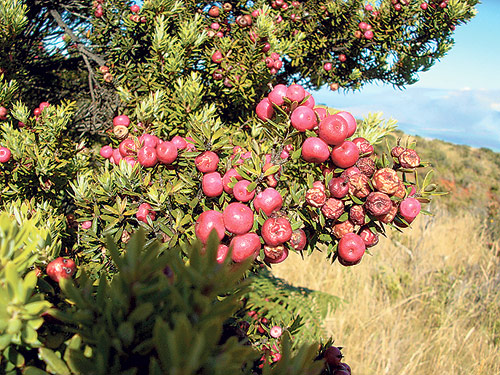Legacy of Kamehameha I woven into pukiawe

This article celebrates the legacy of King Kamehameha I by exploring the solitary native Hawaiian plant that is scientifically named in his honor.
Pukiawe (Leptecophylla tameiameiae) also has the Hawaiian names of aalii mahu, kanehoa, kawau, maiele, maieli, puakeawe, puakiawe, pukeawe and pupukiawe. These various designations are befitting when you consider the full name of our beloved King Kamehameha I: Kalani Paiea Wohi o Kaleikini Kealiikui Kamehameha o Iolani i Kaiwikapu kaui Ka Liholiho Kunuiakea.
The von Kotzebue expedition arrived in Hawaii in 1816. The botanist aboard was Ludolf Karl Adelbert von Chamisso, who, along with Johann Friedrich Eschscholtz, gathered the plant and named it after King Kamehameha I after returning to Berlin.
Pukiawe is indigenous to all the main Hawaiian islands, except Kahoolawe and Niihau, and also to the Marquesas. It survives elevations from a mere 50 feet above sea level to a frigid 10,000 feet. Its habitat can be windward coastal territory, open spaces in low forests, montane wet forests and even alpine bogs and shrublands.
Its diverse environmental range is reflected by the various shapes that pukiawe maintains. It can exhibit as a shallow, sprawling shrub or as an erect, modest tree. The harsh bark is brown to black, and on the tinier twigs a bit scaly. The narrow, leathery leaves are petite and prickly. The top leaf surface is a dull green, and the underside light green to white with distinctive veining.
The diminutive white flowers resemble five-point stars. Round burgundy, red, pink or white fruits contain a hard pit like a peach. Fruits hold five to eight pale-brown, dainty seeds.
Don't miss out on what's happening!
Stay in touch with breaking news, as it happens, conveniently in your email inbox. It's FREE!
Early Hawaiians would take the leaves of pukiawe, mash it with salt, add water and inhale the mixture to treat holopani upe nui (congestion). Fruits and the white liko (new leaf bud) were incorporated into lei. Our state bird, the nene, consumed pukiawe in its free-range diet. The wood was carved into kua kuku (kapa anvil). Criminals were cremated with the wood.
The most extraordinary use of pukiawe involved the ceremony by which an alii would bathe in the fumes of burning dried pukiawe leaves and branches while specific chants were rendered.
As a natural or placed landscaping plant, pukiawe delivers a primordial, textural quality as a hedge or specimen focal point. The fruiting stage of pukiawe is a stunning, visual magnet. Keep in mind, the plant will grow slowly.
I think pukiawe should be weaved as a garland wreath or lei to adorn the King Kamehameha I statue as part of the floral draping ceremony in his merited and entitled honor.
Duane Choy is a native Hawaiian plant specialist. E-mail him at HanaHou@ecologyfund.net.



